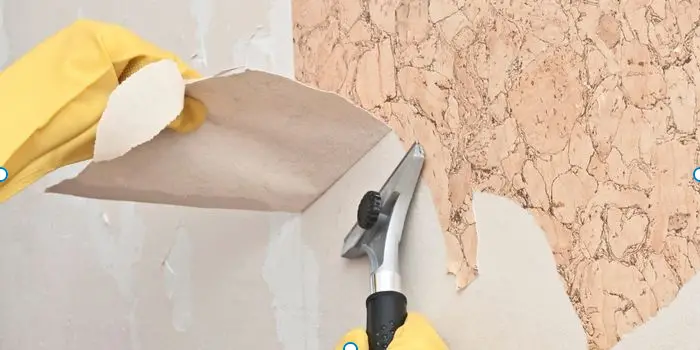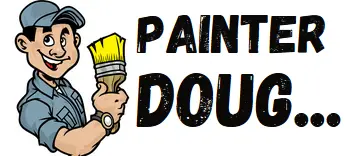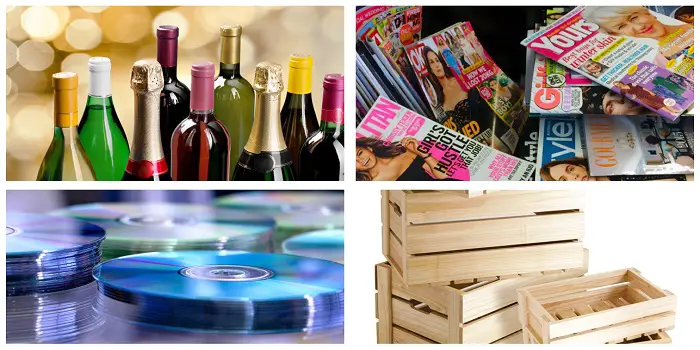
Picture this: It’s been years since you’ve updated the wallpaper in your home, and now you’re ready for a change. The only problem is that you have no idea how to remove vinyl wallpaper without damaging the walls – here enters the clothing steamer.
Removing vinyl wallpaper with a steamer is a pretty simple process, and it’s much less messy than other methods (like manual stripping or using chemical removers).
The gentle heat and moisture soften the adhesive, letting you peel the wallpaper away in satisfying, large sheets, so the job feels less like a chore and more like a quick home refresh.
In this short guide, I will help you figure out the complete process, the preparation you need, and the type of steamer you must use for the best results. So, let’s get started and dive into…
What's Here in the Article:
Stripping Off Vinyl Wallpaper with a Steamer
If your home is decked out in the vinyl wallpaper trend, and now that the wallpaper looks a bit dated, you can remove it using a bit of elbow grease and your regular clothes steamer.
If you do not have a clothing steamer at home, you can borrow one from a friend or even rent a commercial wallpaper steamer.
A powerful Wagner Spraytech Power Steamer can be a good decision to rent or buy if you have a large wallpaper area to strip. Because of the extreme heat, the steam that it generates dissolves the wallpaper adhesive and lets you peel away a layer of wallpaper quickly.
Here’s what you need to do and how to get it done correctly:
Step 1. Check the wallpaper type and the wall
Before you select a remover solution for your walls, be sure to confirm that your wallcovering is, in fact, vinyl wallpaper.
Vinyl-coated wallpaper has a paper base that has been treated with a water-resistant acrylic vinyl coating, ensuring that your walls are protected from the elements while still being aesthetically pleasing.
To know if your wallpaper is vinyl-coated or not grab a damp sponge and drench a small area of the wall. If it absorbs water and turns darker, then you’re dealing with non-vinyl-coated wallpaper like paper or fabric.
It’s also critical to find out what kind of walls your room has. Most homes built in the past 50 years have drywall rather than plaster due to its affordability and lighter weight. Knocking on the surface can confirm whether your walls are plaster or drywall.
You can tell the difference by the fact that plaster produces a solid, dull sound, while drywall gives off a hollow noise. Be careful when using sharp tools around drywall, as it’s easy to damage the underlying cardboard structure.
Step 2. Check if your wallpaper is easily strippable
To see whether your wallpaper is removable or still stuck hard, pry up the bottom seam or corner of a wallpaper panel with a putty knife and try pulling it away.
If the wallpaper comes off effortlessly, try to remove the lower corner from the wall until the lower seam of the wallpaper panel is free, then grasp both corners and pull upwards until the whole strip comes off the wall.
If it isn’t easy to remove, you will need to remove it using warm water and steam to loosen the paste. I recommend creating small holes in the wallpaper before using a steamer to allow the steam to penetrate and loosen the adhesive holding the paper on, making it much easier to remove.
Step 3. Gather the items and prepare the room
To remove the vinyl wallpaper from the walls it’s important to prepare the room and gather some supplies. Here are the items you will generally need:
- Steamer
- A tarp cover
- Step stool
- A wallpaper-scraping tool
- Rubber gloves and eye protection
- Old towels or newspapers to protect baseboards.
Since you are dealing with dripping water and steam, it’s essential to protect your floors, baseboards, furniture, carpets, electric wiring, and outlets before you start.
Cover the floor with a tarp and put some old towels or newspapers around the baseboards to avoid water damage. Also, remove all furniture and area rugs from the room.
Wallpaper steamers release a lot of moisture, so open a window or use fans to prevent condensation. Take the faceplates off light switches and sockets. If you can, turn off the electricity in the room and put waterproof tape over all electrical outlets.
While using the steamer you will be dealing with hot steam, so wear rubber gloves and eye protection to avoid burns.
Step 4. Remove the vinyl wallpaper using steam
Start by filling the steamer’s tank with water and plugging it in.
After a few minutes of heating up, switch on and hold the steamer about 6 inches from the wall and move it slowly back and forth for about 30 to 45 seconds. The steam will do its job, and you’ll see the wallpaper start to peel away.
Switch the steamer off and wait for a while – if you overheat the wet wall, it might melt the drywall or plaster beneath the wallpaper.
Now using your wallpaper scraping tool (putty knife, scraper, or a scoring tool), start detaching the layer of a wallpaper at a corner or seam. This should now get off easily. If not, steam for another 30 seconds.
TIP: If wallpaper borders are placed on top of the primary wallpaper, use a warm water spray to remove the border before applying steam. Remove the entire border so you can peel away any remaining wallpaper more easily.

What if the Wallpaper Adhesive is Still Stubborn?
If your wallpaper is too stubborn and does not get removed, mix some fabric softener with the water in your clothes steamer.
Apply this homemade wallpaper solvent to the paper following the instructions above, letting it sit for 15-20 minutes so the fabric softener can loosen the glue.
If need be, hit it with steam one more time before stripping away the wallpaper and cleaning surfaces.
Another method is to make a vinegar-based stripper. This can be done by mixing one part of white vinegar with four parts of warm water in a bucket.
Apply this mixture to the wallpaper surface with a sponge, wait 15 minutes, and then use a steamer followed by a putty knife or scraper to remove the paper.
After the wallpaper has been removed, you can wash the walls with warm, soapy water to remove any remaining adhesive, rinse with clean water, and allow them to dry completely before priming or painting.
If you want, you can also consider using wallpaper alternatives or decorative paint techniques to give your walls a fresh new look without the hassle of traditional wallpaper.
How to Steam Off Old Vinyl Wallpaper Without a Steamer?
If you don’t have a wallpaper steamer, you can still remove vinyl wallpaper using a mix of warm water, patience, and the right tools.
First, remember that vinyl wallpaper has a plastic-like surface, so water can’t soak through unless you puncture it. Use a wallpaper scoring tool or even the tip of a utility knife to make small holes or scratches across the surface. This lets the moisture reach the adhesive underneath.
Next, fill a spray bottle or bucket with very warm water mixed with a small amount of liquid dish soap (or a vinegar–water mix for extra adhesive loosening).
Spray or sponge the solution generously onto the scored wallpaper, working on small sections at a time. Let it sit for 10–15 minutes so the water penetrates and softens the glue.
Once the adhesive loosens, peel from a seam or corner using a putty knife to lift the paper gently. Pull slowly to avoid tearing, reapplying the solution if it resists. After the vinyl layer comes off, you may find a paper backing still stuck to the wall—this can be soaked again and scraped off in the same way.
Finally, wash the wall with warm, soapy water to remove any leftover glue before painting or re-papering.
Here’s the hack to speed up drying and reduce mess
When you’re removing vinyl wallpaper without a steamer, the mess usually comes from soggy paper clumps sliding down the wall and water dripping everywhere. You can cut that down with two tricks:
Work downward, not randomly – Start at the top of the wall and remove the wallpaper in vertical strips. That way, any loosened adhesive and water run down onto wallpaper you haven’t peeled yet, softening it further instead of just hitting the floor.
Use a damp, warm towel press – Take an old towel, soak it in very warm water, wring it so it’s damp but not dripping, then press it against a scored section of wallpaper for a minute or two.
The heat and moisture penetrate more effectively than just spraying, but without flooding the wall. You can move the towel along as you go—this method keeps the floor cleaner and speeds up glue softening.
Bonus: Lay an old bedsheet or large plastic sheet at the wall’s base to catch all scraps and drips—when you’re done, you just roll it up and toss the mess in one go.
Can a clothes iron be used to remove old wallpaper?
Yes, a clothes iron can be used to remove old wallpaper, but it’s more of a makeshift method than a recommended one. The principle is the same as a wallpaper steamer: heat and moisture soften the adhesive, making it easier to scrape the paper off.
To do this, you hold the iron close to the wall (without touching it directly) and use the steam burst function to loosen the glue.
Once the adhesive softens, you can gently lift and scrape the wallpaper away with a putty knife. This works best for small areas or stubborn patches that a chemical remover hasn’t fully loosened.
However, there are some downsides. Too much direct heat can blister paint, damage drywall, or melt the vinyl layer on some wallpapers.
Over-steaming one spot can also saturate the wall and weaken drywall. An iron covers a very small area, so it’s much slower for large walls, and there’s also the risk of steam burns or hot water drips.
The conclusion
Using a clothes steamer to remove vinyl wallpaper is a practical alternative to a professional wallpaper steamer, especially for small or medium projects. By scoring the vinyl surface, directing steady steam to loosen the adhesive, and peeling the wallpaper slowly, you can achieve clean removal with minimal damage to the wall underneath.
Just remember to work in manageable sections, keep safety in mind when handling hot steam, and follow up with a thorough wall cleaning to remove any remaining glue. This way, your walls will be smooth, dry, and ready for their next finish.
Share the post "How to Use a Clothes Steamer to Remove Vinyl Wallpaper?"

Douglas Becker (aka Painter Doug) has over twenty years of experience as a painter in Adkins, Texas. At present, he resides in Florida with his family.
From painting multi-storeyed houses, condos, and apartments to large commercial buildings and small offices, he had served various customers in areas not only in Adkins but also in Southwest Florida, Sarasota, Naples, and many more. To know more about him check here.




